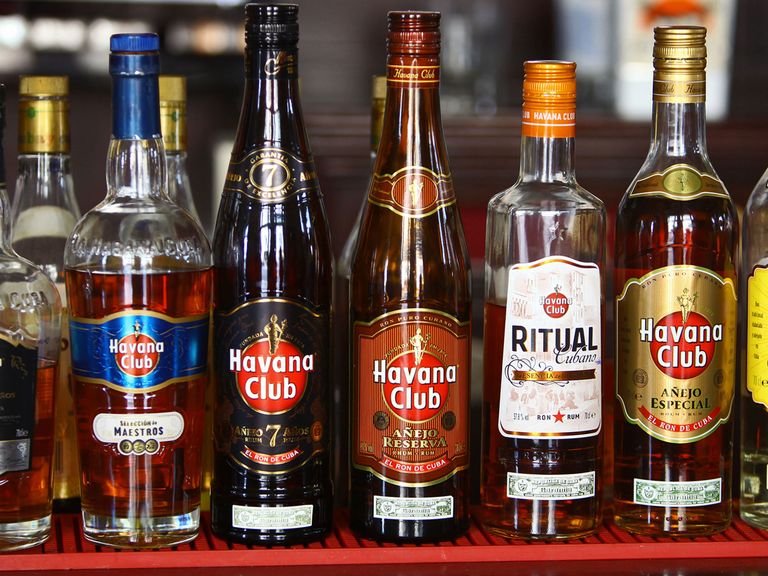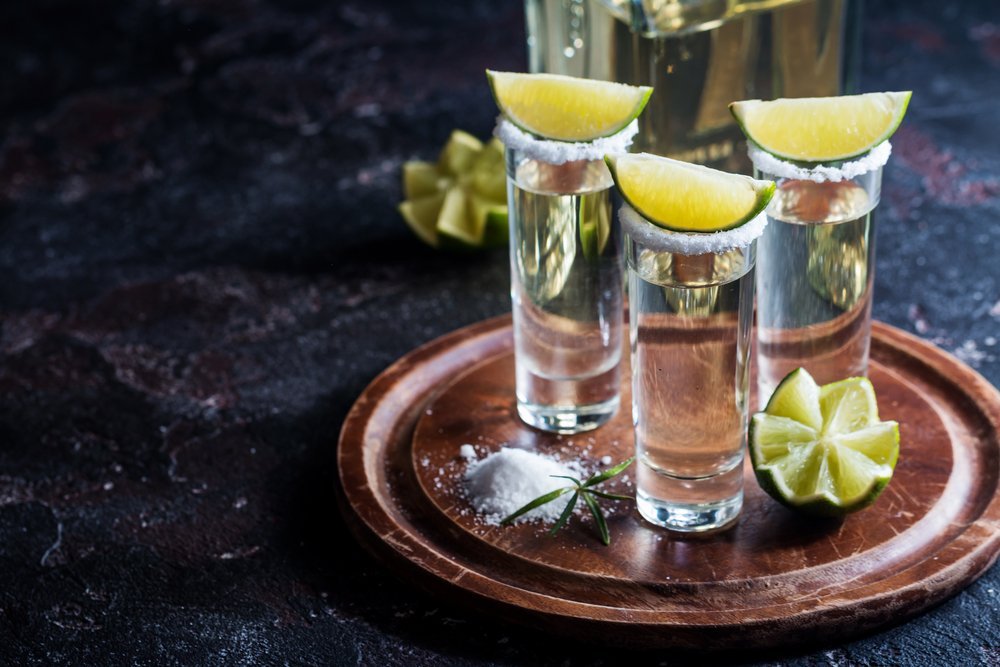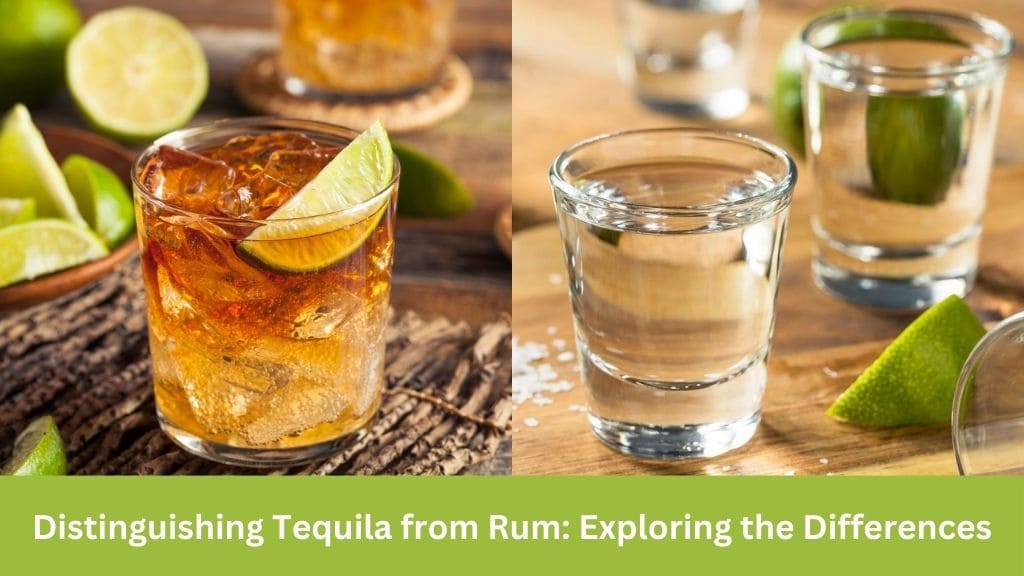When it comes to alcoholic beverages, few are as iconic and diverse as tequila and rum. Originating from different regions and made from distinct ingredients, these spirits offer unique flavors and cultural significance. In this comprehensive guide, we’ll delve deep into the world of tequila and rum, exploring their differences in production, flavor profiles, cultural significance, and more.
Understanding Tequila
Origins and Production Process
Tequila, often hailed as the national spirit of Mexico, boasts a rich history dating back to the early 1800s. It is primarily produced in the Tequila Region of Jalisco, Mexico. The production process begins with the harvesting of blue agave plants. These plants are then processed to extract their juices, which are fermented and distilled to create tequila.
Types of Tequila
/cdn.vox-cdn.com/uploads/chorus_image/image/69797635/EA_012___Tequila___Group10111.0.jpg)
Tequila comes in several varieties, each with its own distinct characteristics:
- Blanco (Silver): Unaged and typically clear in color, blanco tequila offers a crisp and vibrant taste, allowing the natural flavors of the agave to shine through.
- Reposado: Aged in oak barrels for a minimum of two months, reposado tequila takes on subtle hints of wood and vanilla, resulting in a smoother and more complex flavor profile.
- Añejo: Aged for at least one year in oak barrels, añejo tequila exhibits rich caramel and spice notes, with a smooth and velvety texture.
Flavor Profile and Cultural Significance
Tequila is renowned for its bold and robust flavors, characterized by notes of agave, citrus, and pepper. It holds a special place in Mexican culture, often enjoyed during celebrations and social gatherings. Whether sipped neat or mixed into cocktails like the Margarita, tequila is cherished for its versatility and distinctive taste.
Exploring the World of Rum
Origins and Production Process
Unlike tequila, which is specific to Mexico, rum has a more diverse geographical footprint, with production spanning various regions across the globe. It is typically distilled from fermented molasses or sugar cane juice. The production process involves fermenting the base ingredient, followed by distillation and aging in oak barrels.
Types of Rum

Rum comes in a wide range of styles and classifications, catering to diverse preferences:
- Light Rum: Also known as white or silver rum, light rum is clear in color and exhibits a crisp and clean taste, making it ideal for mixing into cocktails.
- Dark Rum: Aged in oak barrels for an extended period, dark rum boasts a rich and complex flavor profile, with notes of caramel, spice, and molasses.
- Flavored Rum: Infused with various natural flavors such as coconut, pineapple, or spices, flavored rum offers a creative twist on traditional varieties.
Flavor Profile and Cultural Significance
Rum is celebrated for its versatility and depth of flavor, ranging from light and fruity to dark and robust. It holds cultural significance in regions where it is produced, such as the Caribbean and Latin America, where it is deeply ingrained in local traditions and festivities. From classic cocktails like the Mojito to timeless favorites like the Daiquiri, rum continues to captivate drinkers worldwide.
Key Differences Between Tequila and Rum
Origins and Geographical Indications

- Tequila: Originates from Mexico, specifically the Tequila Region in Jalisco.
- Rum: Produced in various regions around the world, including the Caribbean, Latin America, and even parts of the United States.
The key differences between tequila and rum extend beyond their flavor profiles and production processes; they also encompass their origins and geographical indications.
Tequila
Tequila is tightly bound to its place of origin, with strict regulations governing its production. It can only be legally produced in certain regions of Mexico, primarily the Tequila Region in the state of Jalisco. This geographical indication ensures that tequila’s authenticity and quality are preserved, as it is intricately tied to the terroir of the region.
The Tequila Region’s volcanic soil, high altitude, and microclimate create optimal conditions for cultivating blue agave plants, the primary ingredient in tequila production. These factors contribute to the unique flavor profile and characteristics of tequila, distinguishing it from other spirits.
Rum
In contrast, rum boasts a more diverse geographical footprint, with production spanning various regions across the globe. While rum has historical ties to the Caribbean, particularly countries like Jamaica, Barbados, and Cuba, it is also produced in Latin America, the United States, and other parts of the world where sugar cane is cultivated.
The geographical diversity of rum production results in a wide range of styles and flavor profiles, influenced by factors such as climate, soil, and local traditions. Each region imparts its own unique characteristics to the rum, creating a rich tapestry of flavors and expressions.
Base Ingredients
- Tequila: Distilled from fermented juices of blue agave plants.
- Rum: Distilled from fermented molasses or sugar cane juice.
Delving deeper into the base ingredients of tequila and rum reveals fundamental distinctions between the two spirits.
Tequila:
Tequila is crafted from the fermented juices of the blue agave plant, specifically the heart of the plant, known as the piña. This succulent core, resembling a giant pineapple, is harvested and processed to extract its sweet juices, which serve as the foundation for tequila production.
Blue agave plants thrive in the volcanic soil of Mexico’s Tequila Region, where they benefit from the region’s unique microclimate and elevation. The agave’s sugars are concentrated over several years of growth, resulting in a rich and flavorful juice that forms the backbone of tequila’s distinctive taste.
Rum:
In contrast, rum is distilled from fermented molasses or sugar cane juice, offering a broader spectrum of base ingredients compared to tequila. Molasses, a byproduct of sugar refining, is a thick, dark syrup with a high sugar content, making it a popular choice for rum production.
Alternatively, some rum producers opt to use fresh sugar cane juice, which imparts a brighter and more vibrant flavor to the final spirit. This variation in base ingredients contributes to the diversity of rum styles and expressions, ranging from light and floral to dark and robust.
Production Processes
- Tequila: Involves harvesting, processing, fermentation, and double distillation of blue agave.
- Rum: Entails fermenting and distilling molasses or sugar cane juice, followed by aging in oak barrels.
The production processes of tequila and rum are intricate and multi-step, involving careful craftsmanship and attention to detail.
Tequila:
- Harvesting and Processing Agave: The process begins with the harvesting of mature blue agave plants, typically after seven to ten years of growth. The heart of the agave plant, known as the piña, is extracted and trimmed to remove its leaves. These piñas are then transported to the distillery for processing.
- Cooking and Extraction: The piñas are cooked in large ovens or autoclaves to convert their starches into fermentable sugars. Once softened, the cooked piñas are crushed to extract their juices, which are then transferred to fermentation tanks.
- Fermentation: Yeast is added to the agave juice, initiating the fermentation process. This step can take several days, during which the sugars in the juice are converted into alcohol, producing a low-proof beer-like liquid known as “mosto.”
- Distillation: The mosto undergoes double distillation in pot stills or column stills, resulting in a high-proof spirit known as “ordinario.” This spirit is then distilled a second time to achieve the desired alcohol content and flavor profile.
- Aging (Optional): Depending on the desired style of tequila, the spirit may be aged in oak barrels for varying lengths of time. Aging imparts additional flavors and complexity to the tequila, with categories such as blanco (unaged), reposado (aged), and añejo (extra-aged) reflecting different aging periods.
Rum:
- Extraction of Base Ingredient: Rum production begins with the extraction of the base ingredient, which can be either molasses or sugar cane juice. Molasses, a byproduct of sugar refining, is often used for its rich flavor and high sugar content. Alternatively, some producers opt for fresh sugar cane juice, which yields a lighter and more aromatic rum.
- Fermentation: The base ingredient is combined with water and yeast to initiate fermentation. This process converts the sugars in the molasses or sugar cane juice into alcohol, producing a fermented liquid known as “wash” or “wine.”
- Distillation: The wash is then distilled in either pot stills or column stills to separate alcohol from impurities and water. This distillation process can be repeated multiple times to achieve the desired level of purity and flavor.
- Aging (Optional): After distillation, rum may be aged in oak barrels for varying periods. Aging enhances the flavor and complexity of the rum, with categories such as white rum (unaged), gold rum (aged), and dark rum (heavily aged) reflecting different aging processes.
Flavor Profiles

- Tequila: Bold and robust flavors, with notes of agave, citrus, and pepper.
- Rum: Versatile flavor profiles, ranging from light and fruity to dark and complex, with notes of caramel, spice, and molasses.
The flavor profiles of tequila and rum are distinct and influenced by various factors, including the base ingredients, production processes, and aging techniques.
Tequila:
- Blanco (Silver): Unaged and bottled shortly after distillation, blanco tequila boasts vibrant and crisp flavors, with prominent notes of agave, citrus, and pepper. Its pure and unadulterated taste showcases the essence of the blue agave plant, offering a refreshing and lively drinking experience.
- Reposado: Aged in oak barrels for a minimum of two months, reposado tequila develops subtle hints of oak, vanilla, and caramel, alongside the signature agave flavors. The aging process imparts a smooth and rounded texture to the tequila, balancing its natural sweetness with delicate spice and wood notes.
- Añejo: Aged for at least one year in oak barrels, añejo tequila exhibits rich and complex flavors of caramel, chocolate, and spice, with a velvety texture and lingering finish. The extended aging period allows the tequila to mellow and mature, resulting in a sophisticated and nuanced drinking experience.
Rum:
- Light Rum: Also known as white or silver rum, light rum is clear in color and offers a clean and crisp taste, with subtle hints of sweetness and floral aromas. It is often used as a base spirit in cocktails, where its neutral flavor profile allows other ingredients to shine.
- Dark Rum: Aged in oak barrels for an extended period, dark rum boasts rich and robust flavors of caramel, molasses, and spice, with a deep and complex character. The aging process imbues the rum with warm and mellow undertones, creating a smooth and full-bodied drinking experience.
- Flavored Rum: Infused with various natural flavors such as coconut, pineapple, or spices, flavored rum offers a playful and aromatic twist on traditional varieties. These flavored rums can range from light and tropical to bold and exotic, appealing to a wide range of palates.
Cultural Significance
- Tequila: Integral part of Mexican culture, often associated with celebrations and social gatherings.
- Rum: Holds cultural significance in regions where it is produced, with deep roots in local traditions and festivities.
The cultural significance of tequila and rum extends far beyond their flavors and production methods, encompassing traditions, rituals, and social customs that have evolved over centuries.
Tequila:
In Mexican culture, tequila holds a revered status as the national spirit and a symbol of national identity. It is deeply intertwined with the country’s history, traditions, and folklore, playing a central role in celebrations, rituals, and social gatherings.
- Celebrations and Festivities: Tequila is an integral part of Mexican celebrations and festivities, such as weddings, birthdays, and holidays like Dia de los Muertos (Day of the Dead). It is often consumed during lively fiestas and cultural events, where it brings people together to toast to life’s joys and blessings.
- Culinary Traditions: Tequila is also celebrated for its culinary versatility, with dishes like carne asada, ceviche, and mole incorporating the spirit into their recipes. From marinades and sauces to desserts and cocktails, tequila adds depth and complexity to Mexican cuisine, enhancing flavors and elevating dining experiences.
- Art and Music: Tequila has inspired countless works of art, literature, and music, serving as a muse for artists, writers, and musicians alike. Its rich cultural heritage and iconic status have been immortalized in paintings, novels, and songs that capture the spirit and essence of Mexico’s vibrant and dynamic culture.
Rum:
Similarly, rum holds cultural significance in regions where it is produced, such as the Caribbean, Latin America, and parts of the United States. It is deeply ingrained in local traditions, customs, and folklore, serving as a symbol of community, heritage, and identity.
- Colonial Legacy: Rum’s history is closely tied to the colonial era, when sugar plantations and rum distilleries flourished in the Caribbean. The spirit played a pivotal role in the region’s economy and trade, shaping its cultural landscape and social fabric.
- Cultural Celebrations: Rum is a central element of Caribbean celebrations and festivals, such as Carnival, Crop Over, and Junkanoo. It is often consumed during parades, parties, and street festivities, where it fuels the revelry and camaraderie of the occasion.
- Craftsmanship and Tradition: Rum production is steeped in craftsmanship and tradition, with many distilleries preserving age-old techniques and recipes passed down through generations. From small-batch artisanal rums to large-scale commercial brands, rum represents a proud legacy of craftsmanship and innovation.
Does rum and tequila go together?
Rum and tequila can certainly be enjoyed together in cocktails or mixed drinks, but it’s important to consider the flavors and characteristics of each spirit when combining them. While both rum and tequila offer unique profiles, they can complement each other well when paired thoughtfully.
Some cocktail recipes incorporate both rum and tequila to create complex and interesting flavor combinations. For example, a Rum Margarita substitutes rum for the traditional tequila in a classic Margarita recipe, offering a twist on the original cocktail. Similarly, a Rum Punch may include both rum and tequila along with fruit juices and other ingredients for a refreshing and tropical beverage.
However, it’s essential to balance the flavors of rum and tequila appropriately to ensure a harmonious blend. Experimenting with different ratios and ingredients can help achieve the desired taste and balance in mixed drinks. Ultimately, whether rum and tequila go together depends on personal preference and the specific cocktail recipe being used.
What happens when you mix rum and tequila?
When you mix rum and tequila, you create a fusion of flavors that can result in a unique and complex taste experience. The specific outcome will depend on the types of rum and tequila used, as well as any additional ingredients in the mix. Here are a few potential outcomes:
- Enhanced Complexity: Combining rum and tequila can enhance the overall complexity of the drink, as each spirit brings its own distinct flavors to the mix. Rum may contribute notes of caramel, vanilla, and spice, while tequila adds elements of agave, citrus, and pepper.
- Balanced Flavor Profile: When mixed in the right proportions, rum and tequila can create a balanced flavor profile that combines the sweetness of rum with the crispness of tequila. This balance is crucial to creating a harmonious and enjoyable drink.
- Creative Cocktail Creations: Mixing rum and tequila opens up a world of possibilities for creative cocktail creations. Bartenders and enthusiasts can experiment with different combinations of spirits, mixers, and garnishes to craft unique and flavorful drinks.
- Potent Potions: It’s important to note that combining rum and tequila can result in a potent cocktail, especially if both spirits are high-proof. As such, it’s essential to drink responsibly and be mindful of the alcohol content when enjoying mixed drinks containing both rum and tequila.
Mixing rum and tequila can lead to delicious and inventive cocktails that showcase the best of both spirits. Whether you’re sipping a Rum Margarita, a Tequila Sunrise with a rum float, or a custom concoction of your own creation, the possibilities are endless when these two iconic spirits come together.
Conclusion
In conclusion, while tequila and rum share similarities as popular spirits enjoyed worldwide, they also exhibit distinct differences in origins, production processes, flavor profiles, and cultural significance. Whether you’re sipping a smooth añejo tequila or indulging in a rich and flavorful dark rum, each spirit offers a unique journey for the senses, inviting enthusiasts to explore the rich tapestry of flavors and traditions that define the world of distilled spirits. So, whether you’re raising a glass of tequila in Mexico or enjoying a refreshing rum cocktail in the Caribbean, take a moment to appreciate the craftsmanship and heritage that goes into each sip of these beloved spirits. Cheers!
I’m Chen Mina, from Vol de Nuit, who has a special passion for bartending, especially mixing wine, beer, and cooktail. Here you will find content about alcoholic beverages, I will bring you knowledge that few people know about this drink.





